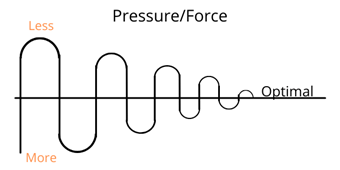These three games are fun to play with musicians as they help build awareness of habits the musician has and what other options might be available. The games are based on the concept of pendulation where the musician discovers optimal balance, force, and performance presence while playing. It is a fun game to repeat and often useful at the beginning of a lesson or when students begin to develop detrimental habits. In each game it is helpful to go slowly enough to build awareness of the physical sensory experience of the ends of the pendulation and then the middle and most likely optimal moments we want to cultivate.
Game I: Finding the Best Posture and Balance
This game is helpful for musicians who stand mostly on one leg, tilt in one direction, or twist in one direction more than the other, for instance. Balancing on one leg is used as an example for the game. and can be applied to any other circumstance where improvement is needed.
Stand on one leg completely. Slowly move to the other leg completely. Keep the hips, knees, and ankles easy. Slowly move back and forth between the two supports diminishing the amount of shift from side to side until there is very little sideways movement. Find the moment when there is equal support on both legs. This can be done while standing on two supports or on the sit bones while at the keyboard or drums.
It can first be done without any contact with the instrument. Then while supporting or contacting the instrument, while playing scales, and then while reading music.
Game II: Playing with Optimal Force
This game is best for those who use their arms and fingers to play an instrument. Using the drums as an example, experiment with how little and how much force it takes to produce sound. Or with a flute, how much and how little pressure it takes to close a finger hole.
While exploring your airflow, avoid squeezing your throat and larynx so you stay healthy.
Game III: Performance Presence
This game is especially useful for musicians who get nervous in front of others while playing. The goal is to include the musician in the spatial field of the practice area, performance area, or stage. It is also useful for ensemble and choral work.
Start by noticing only oneself in the room and then pendulate out to notice only the perimeter of the room. Gradually move back and forth between each extreme until both can be held in focus at one time.
A variation: You can also begin by noticing oneself only and then adding small increments of space, e.g. oneself and 3 inches away, oneself and the other musicians in the room (if developing ensemble work) oneself and the middle of the room, oneself and the surrounding walls.
All of these games have multiple variations and applications. This type of self awareness and discovery are helpful in teaching students that there is not only one way to make music. It cultivates a sense of discovery and curiosity and gives self agency to the musician.



